Content Automation in Marketing: Best Practices

At Drop Cowboy, we’ve seen firsthand how content automation marketing is reshaping the industry. This powerful approach combines artificial intelligence with streamlined workflows to revolutionize content creation and distribution.
Content automation not only saves time and resources but also enables personalized experiences at scale. In this post, we’ll explore best practices for leveraging AI, implementing efficient workflows, and striking the right balance between automation and human creativity.
How AI Revolutionizes Content Creation
The AI Content Revolution
AI-powered content generation transforms the marketing landscape. These advanced systems analyze vast data sets to produce human-like text, creating various content types from blog posts to social media updates in record time.
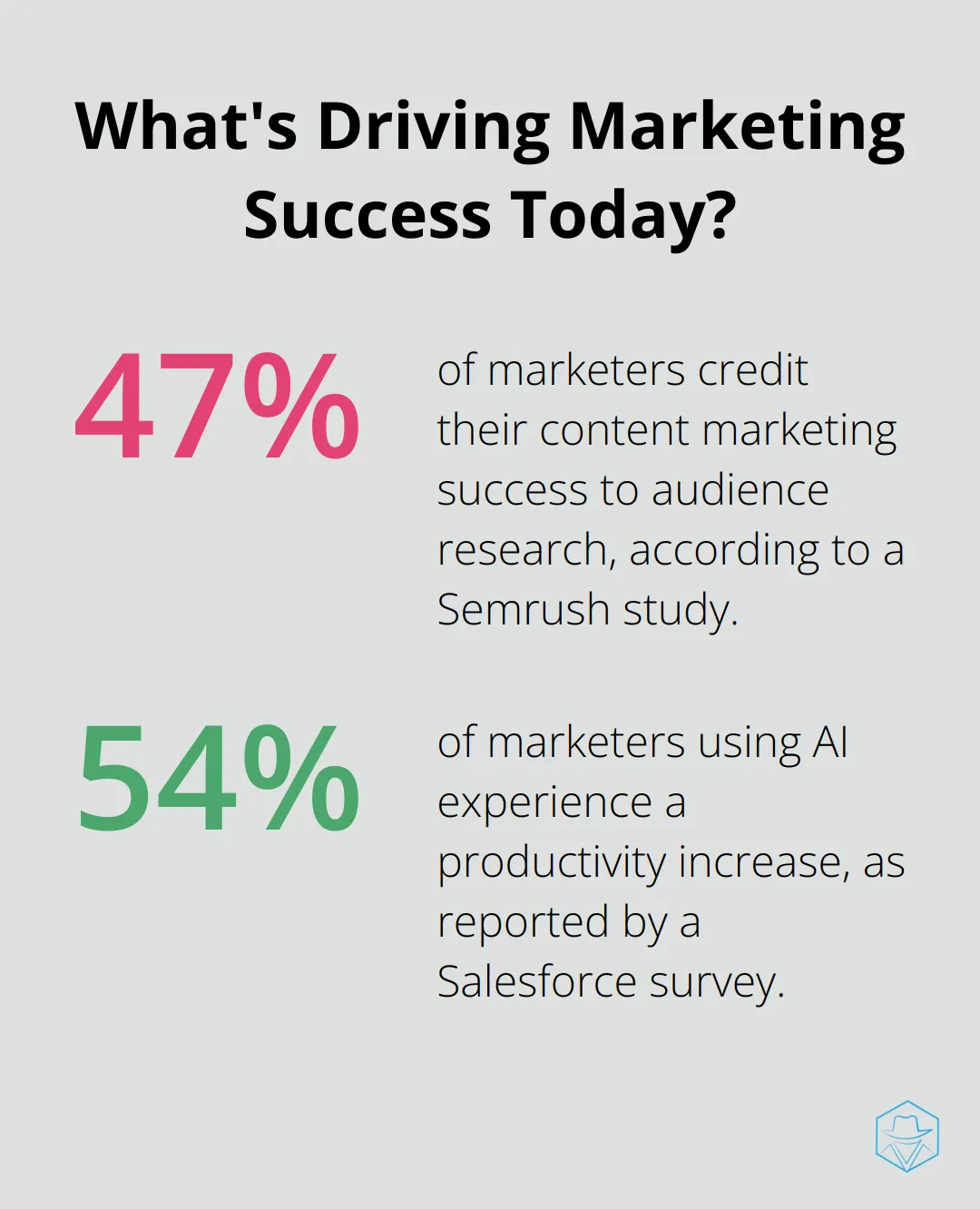
A recent Semrush study reveals that 47% of marketers credit their content marketing success to audience research. AI excels at this task, processing user data to identify trends and preferences that shape content strategy.
Supercharging Content Marketing with AI
AI offers substantial benefits in content marketing. A Salesforce survey reports that marketers using AI experience a 54% productivity increase. This boost stems from AI’s ability to:
- Generate content ideas at scale
- Produce first drafts quickly
- Optimize content for SEO
- Personalize content for different audience segments
Top AI Content Creation Tools
Several AI tools lead the content creation space:
- GPT-3 based platforms for long-form content
- Jasper for versatile content generation
- Copysmith for marketing copy and product descriptions
While powerful, these tools require human oversight. AI-generated content needs review, editing, and infusion with brand voice and expertise.
Implementing AI in Your Content Strategy
To leverage AI effectively in your content marketing:
- Start small (use AI for content ideation or headline generation)
- Experiment with different tools to find the best fit
- Develop guidelines for AI usage to maintain brand consistency
- Train your team to work effectively alongside AI tools
The Future of AI-Powered Content
As AI technology advances, its potential to revolutionize content marketing grows. Marketers who embrace AI-powered content creation can produce more engaging, personalized content at scale, driving better results and ROI.
The next frontier in content automation involves implementing efficient workflows. These processes streamline content creation and distribution, maximizing the benefits of AI-generated content while ensuring consistency and quality across all marketing channels.
Streamlining Your Content Workflow
Identifying Time-Consuming Tasks
Marketing teams often spend up to 20 hours per week on repetitive tasks that automation could handle (according to a Smartsheet study). To streamline your content workflow, you must first pinpoint these time-consuming activities. Common candidates for automation include:
- Social media post scheduling
- Email newsletter creation and distribution
- Content curation and aggregation
- Basic image editing and resizing
- Report generation and data analysis
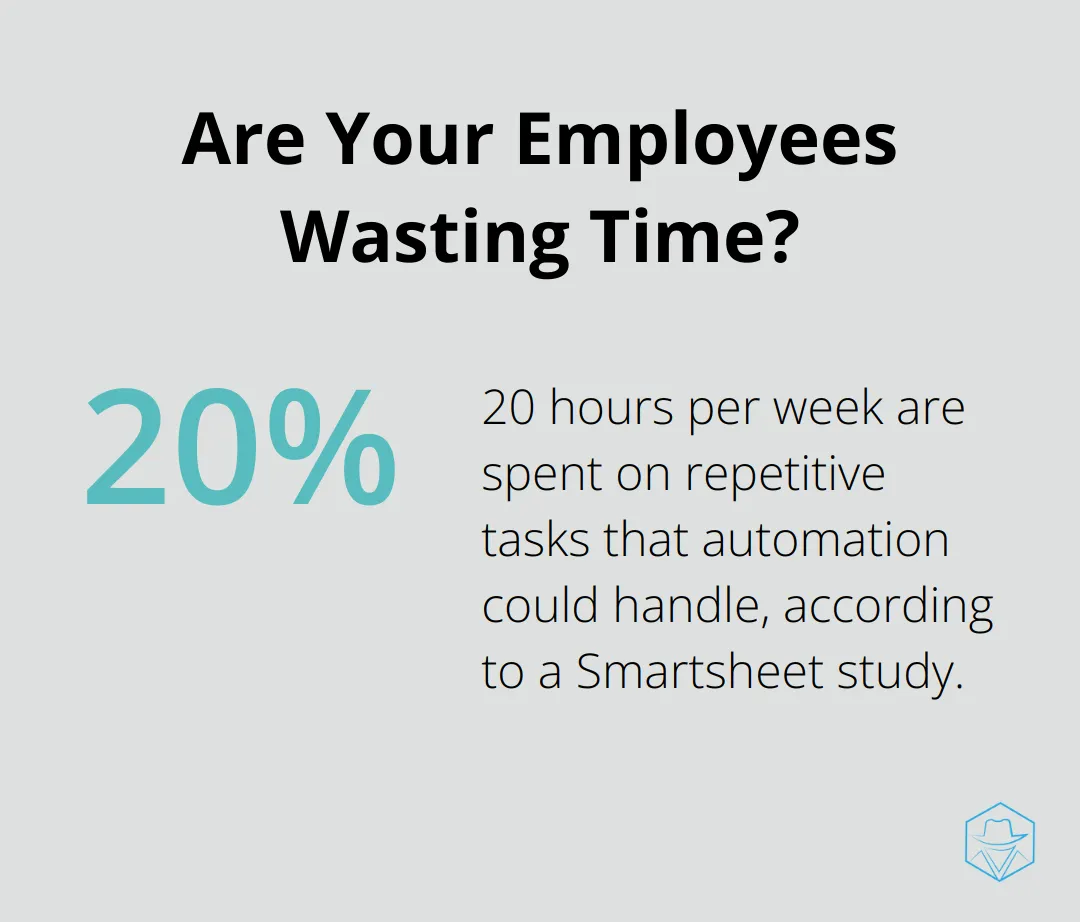
Automation of these tasks allows teams to focus on strategic thinking and creative work. (For example, some companies have reduced time spent on social media posting by up to 70% through automation.)
Automating Content Distribution
Efficient content distribution ensures your message reaches the right audience at the optimal time. Here are effective strategies to automate this process:
- Use scheduling tools to post content across multiple platforms simultaneously
- Set up RSS feeds to automatically share blog posts on social media
- Create email drip campaigns to nurture leads with relevant content over time
- Utilize chatbots to deliver personalized content recommendations based on user behavior
A study by Epsilon found that automated emails generate 320% more revenue than non-automated emails, highlighting the power of automation in driving engagement and conversions.
Integrating with Existing Marketing Tools
To maximize the effectiveness of your content automation, you must integrate these processes with your existing marketing stack. This integration creates a cohesive ecosystem where data flows seamlessly between different tools. Some key integrations to consider:
- Connect your CRM with your email marketing platform to personalize content based on customer data
- Integrate your content management system with your social media scheduling tool for streamlined publishing
- Link your analytics platform with your content creation tools to inform data-driven decisions
The goal of content automation is not to replace human creativity but to enhance it. These workflows allow you to produce high-quality, strategic content while automation handles repetitive tasks.
As you refine your content automation processes, you’ll discover increased efficiency and consistency in your marketing efforts. However, automation alone isn’t enough. The next step is to harness the power of personalization to create truly engaging content experiences for your audience.
How to Personalize Automated Content
Leverage Data for Tailored Experiences
Personalization transforms automated content into powerful, resonant messages. We start by tapping into our data goldmine. User behavior, purchase history, and demographic information create detailed customer profiles. These insights allow us to segment our audience and deliver content that speaks directly to their interests and needs.
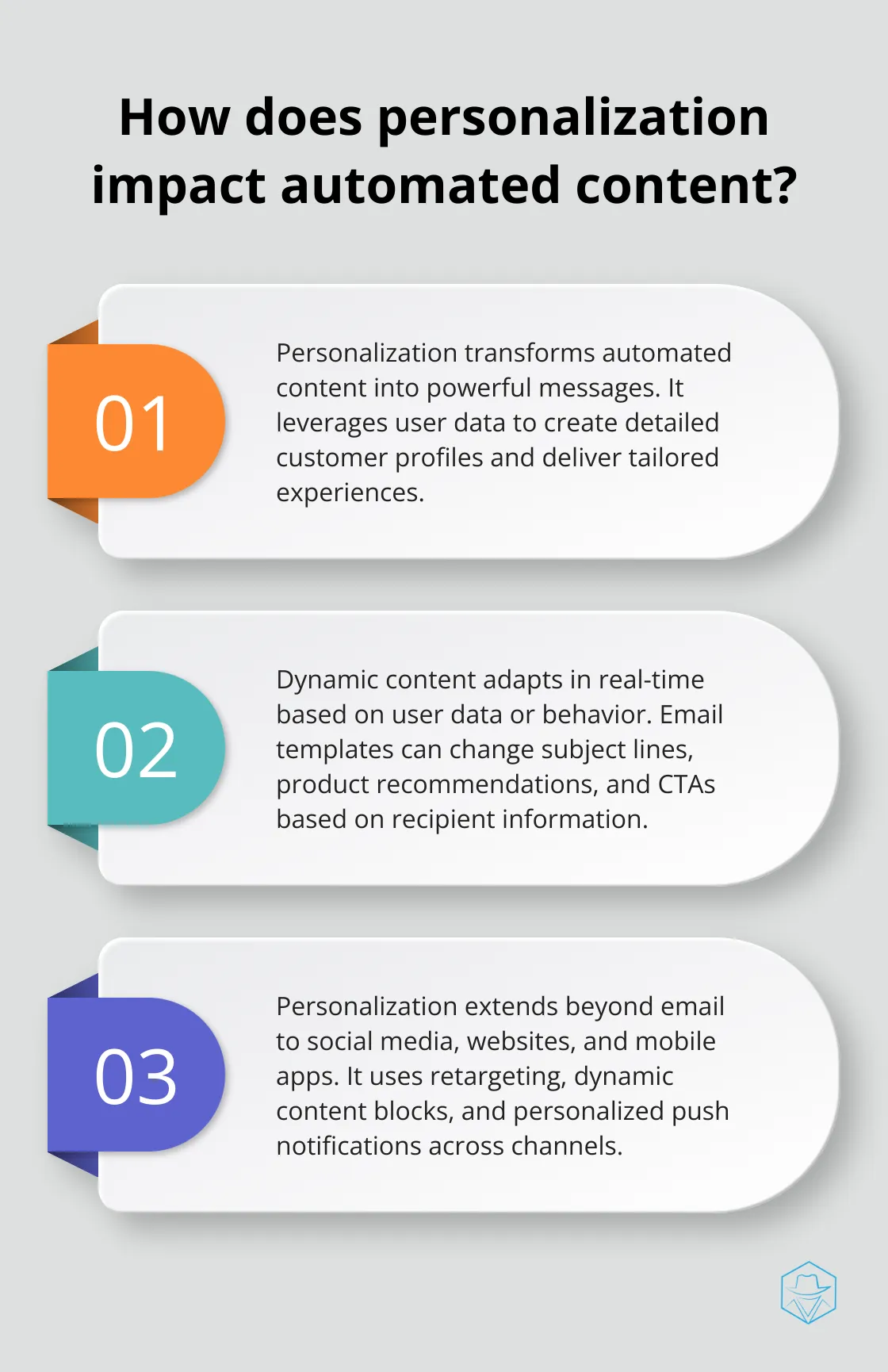
An e-commerce company might use past purchase data to recommend complementary products in follow-up emails. A B2B software firm could tailor case studies based on a prospect’s industry or company size. (This approach often leads to higher engagement rates and conversions.)
We always respect privacy regulations when collecting and using customer data. Transparency about data usage builds trust and encourages users to share more information, enabling even better personalization.
Implement Dynamic Content Elements
Dynamic content adapts in real-time based on user data or behavior. This technique allows us to create a single piece of content that changes for each recipient.
We can create an email template where the subject line, product recommendations, and call-to-action change based on the recipient’s location, past interactions, or stage in the buyer’s journey. (Many email marketing platforms offer these dynamic content features.)
We suggest starting small – perhaps by personalizing email greetings or adjusting content based on gender. As you become more comfortable, you can implement more complex personalization strategies.
Strike the Right Balance
Automation and AI handle much of the heavy lifting, but the human touch remains essential. Your team’s creativity, empathy, and strategic thinking truly set your content apart.
We use automation to handle repetitive tasks and data analysis. This frees up our team to focus on high-level strategy and creating emotionally resonant content. For example, we might use AI to generate data-driven insights about our audience, but rely on human writers to craft compelling narratives that speak to those insights.
We regularly review and refine our automated content to ensure it aligns with our brand voice and values. We set up processes for human oversight, especially for sensitive topics or high-stakes communications.
Personalize Across Channels
Effective personalization extends beyond email. We apply these principles across all marketing channels:
- Social media: Use retargeting to show personalized ads based on previous interactions.
- Website: Implement dynamic content blocks that change based on visitor behavior or demographics.
- Mobile apps: Send push notifications with personalized offers or content recommendations.
Measure and Optimize
To improve our personalization efforts, we track key metrics:
- Engagement rates (opens, clicks, time on page)
- Conversion rates
- Customer satisfaction scores
We use these insights to refine our personalization strategies continually. A/B testing helps us identify which personalized elements resonate most with our audience.
Final Thoughts
Content automation marketing has transformed how businesses create, distribute, and personalize their marketing efforts. AI-powered tools, efficient workflows, and personalized content at scale enable companies to achieve remarkable results in productivity, engagement, and ROI. Companies should identify repetitive tasks for automation, integrate tools with existing marketing stacks, and use data-driven insights to tailor content across channels.
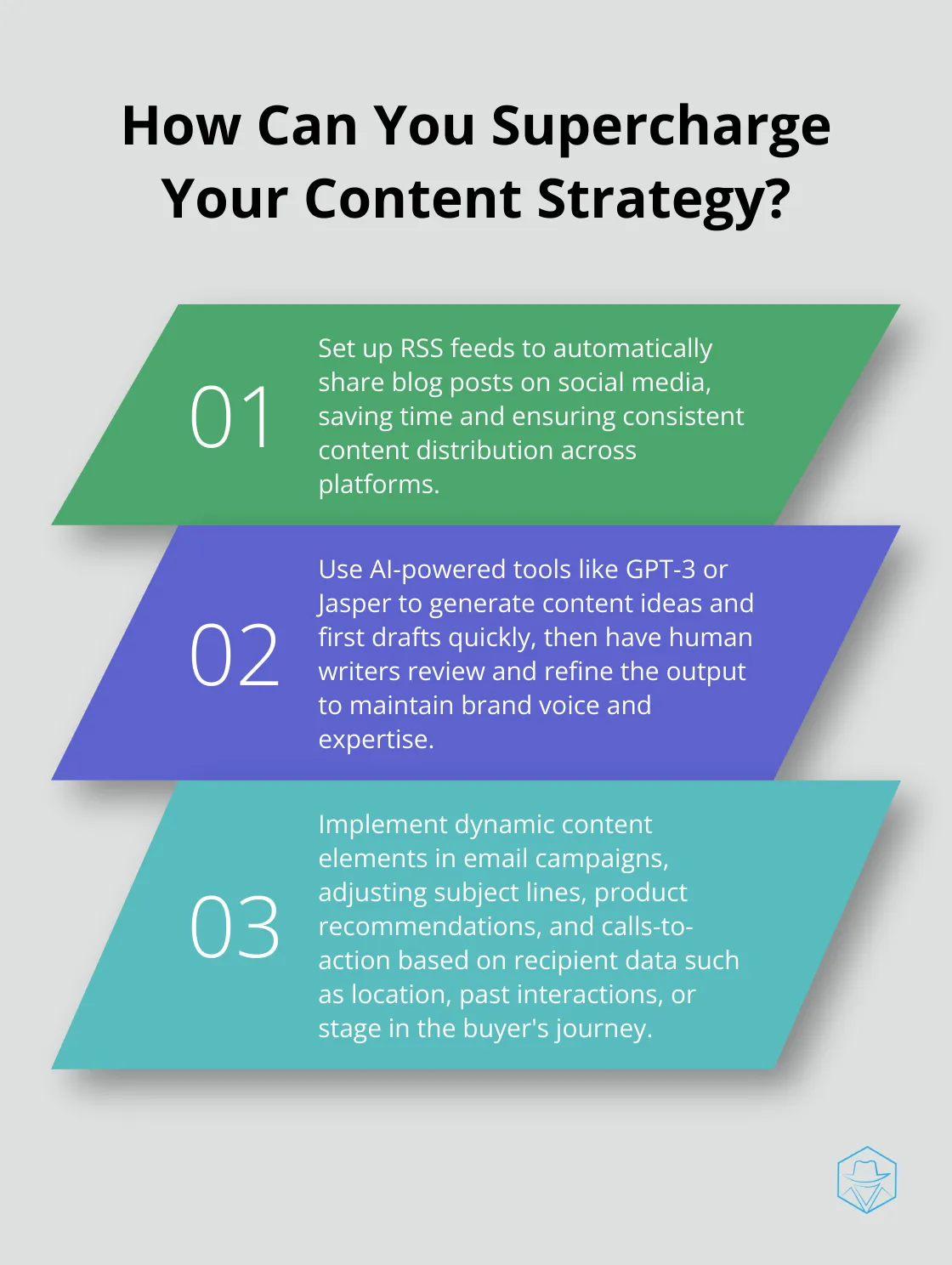
The future of content automation technology promises more sophisticated AI models and advanced personalization algorithms. Human creativity will remain essential in crafting emotionally resonant messages and overseeing AI-generated content. The goal is to enhance human creativity, not replace it, striking the right balance between automation and personalization.
At Drop Cowboy, we understand the power of automation in marketing communications. Our platform enhances marketing efforts through ringless voicemail and SMS, allowing businesses to automate campaigns and track results efficiently. Content automation marketing empowers marketers to create impactful content that drives results and business growth.
Ryan
Ryan is a dedicated expert in SMS and Ringless Voicemail, constantly exploring new ways to optimize communication and engagement through these channels. He’s passionate about leveraging automation and personalization to enhance outreach strategies.
Related posts

March 20, 2025
CRM Marketing Automation: Streamline Your Campaigns
Streamline campaigns with CRM marketing automation. Boost productivity and drive growth through efficient, targeted marketing strategies.

March 12, 2025
How to Create an Effective Marketing Automation Journey
Boost your business by creating an effective marketing automation journey. Streamline processes, engage customers, and drive growth effortlessly.

March 12, 2025
How to Use Ringless Voicemail for Better Results
Learn how to achieve better results with the best ringless voicemail techniques. Optimize outreach for success with proven methods and tips.

March 29, 2025
Top Marketing Automation Companies to Watch
Explore top marketing automation companies revolutionizing marketing strategies with innovative tools and proven results for businesses of all sizes.

March 9, 2025
Creating Compelling Content with Marketing Text Generators
Create captivating content with marketing text generators. Discover trends, tips, and tools to boost engagement and achieve better results.
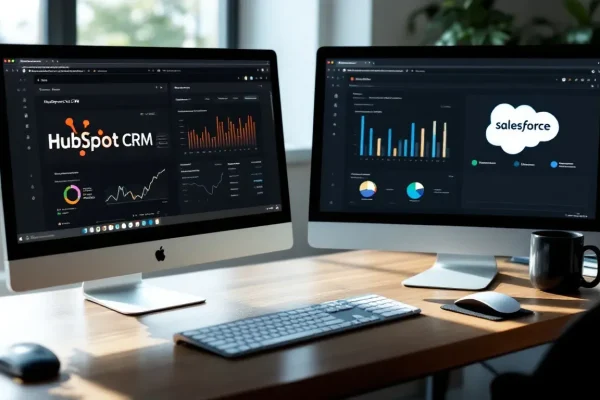
March 30, 2025
HubSpot vs Salesforce: Which CRM Is Right for You?
Compare HubSpot vs Salesforce to find the best CRM for your business. Explore features, pricing, and user experiences in this comprehensive guide.